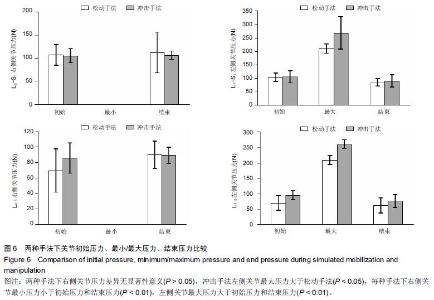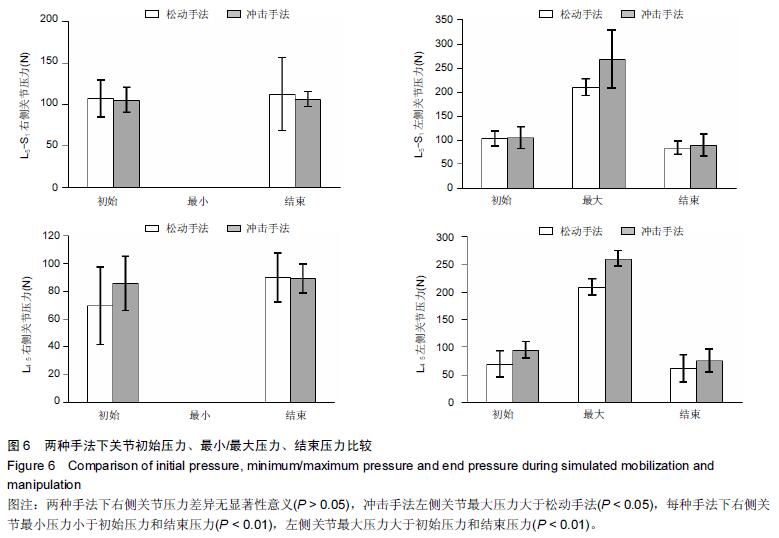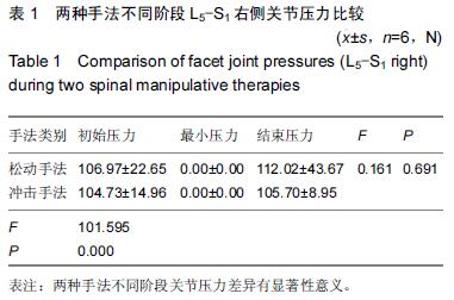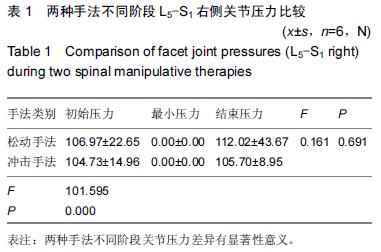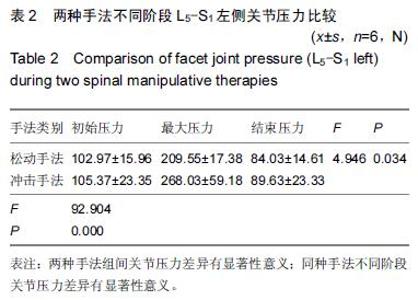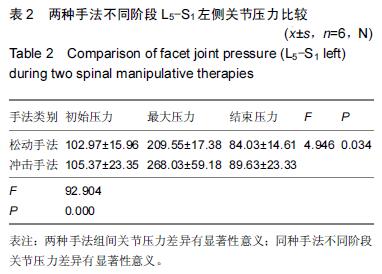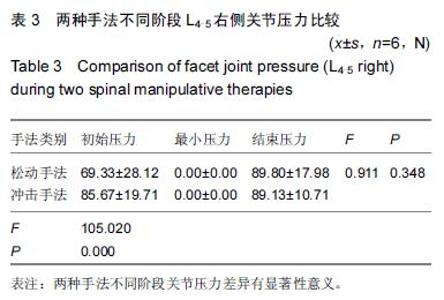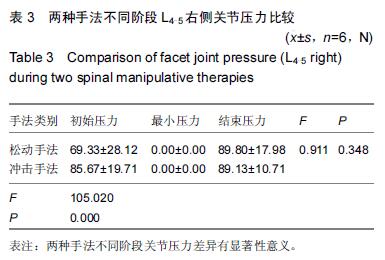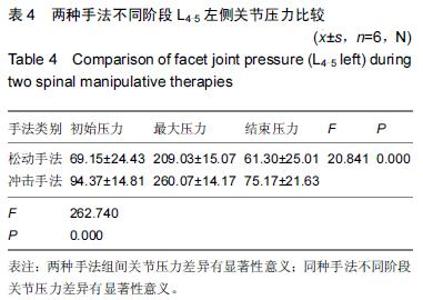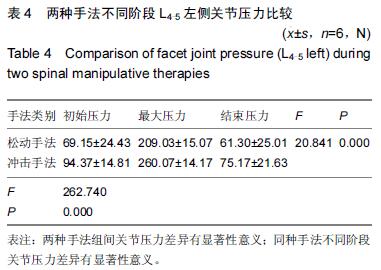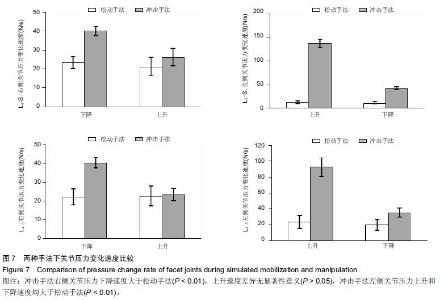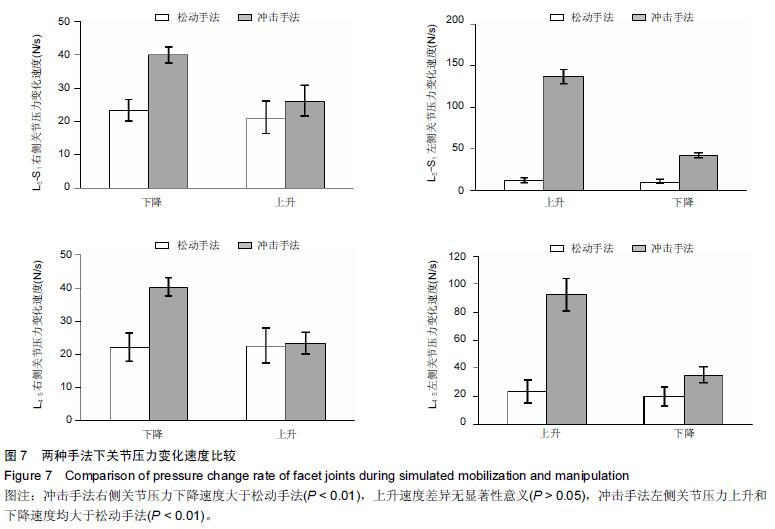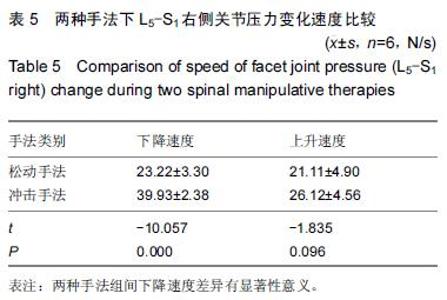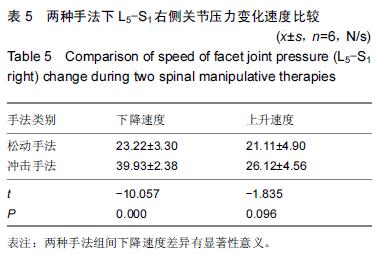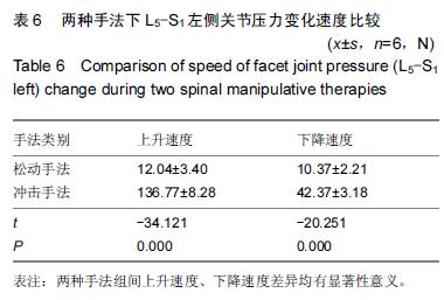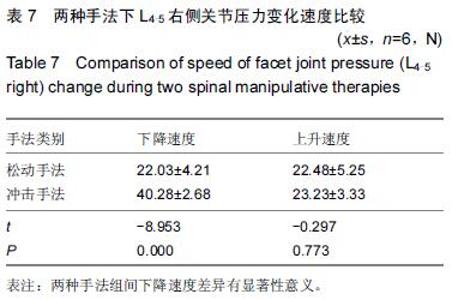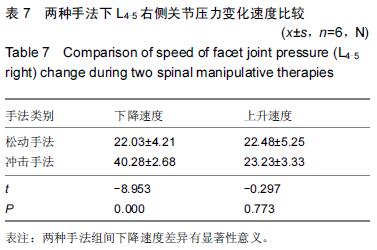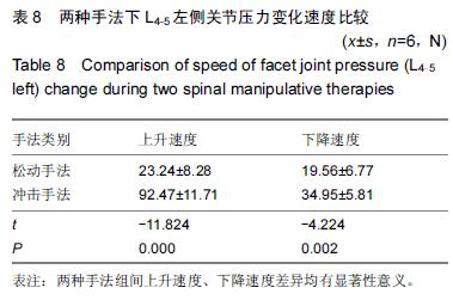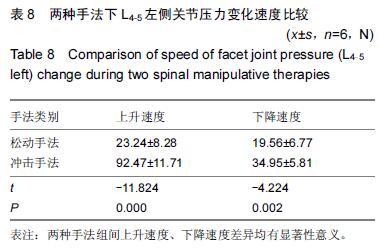Chinese Journal of Tissue Engineering Research ›› 2016, Vol. 20 ›› Issue (17): 2546-2554.doi: 10.3969/j.issn.2095-4344.2016.17.016
Previous Articles Next Articles
Conduction characteristics of human lumbar facet joint pressures during simulated spinal manipulation versus spinal mobilization
Zhang Jun1, Wang Fei2, Liu Qiang1, Zhang Hui3, Sun Pei-dong4, Liang Dong-zhu4, Zhao Ping2
- 1Department of Sinew Injury Manual Therapy Research, Wangjing Hospital of China Academy of Chinese Medical Sciences, Beijing 100102, China; 2Department of TCM Manipulative Orthopedics, Air Force General Hospital of Chinese PLA, Beijing 100142, China; 3Department of Rehabilitation Medicine, Beijing DCN Orthopedic Hospital, Beijing 100143, China; 4Department of Human Anatomy, Southern Medical University, Guangzhou 510515, Guangdong Province, China
-
Received:2016-03-09Online:2016-04-22Published:2016-04-22 -
Contact:Wang Fei, Studying for doctorate, Attending physician, Department of TCM Manipulative Orthopedics, Air Force General Hospital of Chinese PLA, Beijing 100142, China -
About author:Zhang Jun, M.D., Chief physician, Department of Sinew Injury Manual Therapy Research, Wangjing Hospital of China Academy of Chinese Medical Sciences, Beijing 100102, China -
Supported by:the National Natural Science Foundation of China, No. 81373657
Cite this article
Zhang Jun, Wang Fei, Liu Qiang, Zhang Hui, Sun Pei-dong, Liang Dong-zhu, Zhao Ping. Conduction characteristics of human lumbar facet joint pressures during simulated spinal manipulation versus spinal mobilization[J]. Chinese Journal of Tissue Engineering Research, 2016, 20(17): 2546-2554.
share this article
| [1] Bronfort G, Haas M, Evans RL, et al. Efficacy of spinal manipulation and mobilization for low back pain and neck pain: a systematic review and best evidence synthesis. Spine J. 2004;4(3):335-356. [2] Leininger B, Bronfort G, Evans R, et al. Spinal manipulation or mobilization for radiculopathy: a systematic review. Phys Med Rehabil Clin N Am. 2011; 22(1):105-125. [3] Zhang W, Guo W, Zhao P, et al. Therapeutic effects of Chinese osteopathy in patients with lumbar disc herniation. Am J Chin Med. 2013;41(5):983-994. [4] 冯伟,冯天有,王飞等脊柱定点旋转复位法治疗游离型腰椎间盘突出症[J]. 中国骨伤,2008, 21(7):529-531. [5] Chiradejnant A, Latimer J, Maher CG. Forces applied during manual therapy to patients with low back pain. J Manipulative Physiol Ther. 2002;25(6):362-369. [6] Herzog W. The biomechanics of spinal manipulation. J Bodyw Mov Ther. 2010;14(3):280-286. [7] Downie AS, Vemulpad S, Bull PW. Quantifying the high-velocity, low-amplitude spinal manipulative thrust: a systematic review. J Manipulative Physiol Ther. 2010; 33(7):542-553. [8] Henderson CN. The basis for spinal manipulation: chiropractic perspective of indications and theory. J Electromyogr Kinesiol. 2012;22(5):632-642. [9] Haldeman S. Principles and practice of chiropractic. 3rd Edition. McGraw-Hill Medical Publishing, 2005:368-370. [10] 郭伟.腰椎关节不同手法的临床疗效分析和手法生物力学特征研究[D].北京:中国中医科学院,2014:153. [11] 毕胜,李义凯,汪爱媛,等.不同推拿手法下腰椎小关节应力变化的观察[J].中国康复医学杂志,2001,16(3):144-145. [12] Avramov AI, Cavanaugh JM, Ozaktay CA, et al. The effects of controlled mechanical loading on group-Ⅱ,Ⅲ and Ⅳ afferent units from the lumbar facet joint and surrounding tissue: an in vitro study. J Bone Joint Surg Am. 1992;74(10):1464-1471. [13] Triano J, Schultz AB. Loads transmitted during lumbosacral spinal manipulative therapy. Spine. 1997; 22(17):1955-1964. [14] Van Zoest GG, Gosselin G. Three-Dimensionality of direct contact forces in chiropractic spinal manipulative therapy. J Manipulative Physiol Ther. 2003;26(9): 549-556. [15] Herzog W, Conway PJ, Kawchuk GN, et al. Forces exerted during spinal manipulative therapy. Spine. 1993;18(9):1206-1212. [16] 刘强.循环载荷条件下模拟腰椎扳法对椎间盘内压的影响[D].北京:中国中医科学院,2013:57-63. [17] 郭伟,龚成,韩磊,等.冲击手法和松动手法的力学测量和疗效分析[J].空军医学杂志,2015,31(4):226-229. [18] 唐恒涛,赵卫东,吴学建.ISOBAR TTL半坚强动态固定系统对腰椎固定节段关节突关节载荷的影响[J].中华实验外科杂志,2015,32(3):593-595. [19] 赵卫东,徐波,张美超,等. 颈椎三维运动对关节突关节压力的作用[J].中国组织工程研究与临床康复,2010,14(22): 3996-3999. [20] Wu JZ, Herzog W, Epstein M. Effects of inserting a pressensor film into articular joints on the actual contact mechanics. J Biomech Eng. 1998;120(5):665-659. [21] Minns RJ, Walsh WK. Preliminary design and experimental studies of a novel soft implant for correcting sagittal plane instability in the lumbar spine. Spine. 1997; 22(16):1819-1825. [22] Hedman TP, Fernie GR. Mechanical response of the lumbar spine to seated postural loads. Spine. 1997; 22(7):734-743. [23] 胡孔和,吴强,李康华,等.人工颈椎间盘置换术后邻近下位关节突关节压力变化的生物力学研究[J].临床生物力学, 2009,27(4):474-476. [24] 吴强,卢海波,李康华,等.颈椎前路不同术式对邻近下位关节突关节压力影响的生物力学研究[J].国际医药卫生导报, 2009,15(23):1-5. [25] 李康华,肖文峰,胡建中,等.人工腰椎间盘置换后下位关节突关节内压力的变化[J].中国组织工程研究与临床康复, 2008,12(4):631-634. [26] 胡新佳,李康华.腰椎间盘切除与人工椎间盘置换前后上位关节突关节内压力改变[J].中国修复重建外科杂志,2005, 19(6):427-430. [27] 杨红波,李康华,唐磊彬,等.C5/6椎间盘置换术后C3/4关节突关节内压力变化的生物力学研究[J].湖南师范大学学报(医学版),2012,9(3):68-71. [28] Chang UK, Kim DH, Lee MC, et al. Changes in adjacent-level disc pressure and facet joint force after cervical arthroplasty compared with cervical discectomy and fusion. J Neurosurg Spine. 2007;7(1):33-39. [29] Zhu QA, Park YB, Sjovold SG, et al. Can extra-articular strains be used to measure facet contact forces in the lumbar spine? An in-vitro biomechanical study. Proc Inst Mech Eng H. 2008;222(2):171-184. [30] Wang H, Xu DQ, Hu JZ,et al.Three-dimensional finite element analysis of the zygapophyseal joints following artificial lumbar disc replacement. J Clin Rehab Tissue Eng Res. 2010;14(26):4915-4919. [31] 徐力鹏,肖进,张美超,等.腰椎小关节承载功能的三维有限元分析[J].创伤外科杂志,2006,8(2):140-143. [32] 原芳,蒲婷,廖振华,等.Prestige LP和Discover人工颈椎间盘的生物力学有限元分析[J].北京生物医学工程,2014, 33(1):13-20. [33] 马信龙,马剑雄,徐卫国,等.骨科生物力学研究的测量方法专家共识[J].中国骨质疏松杂志,2014,20(9):1039-1054. [34] Wilson DC, Niosi CA, Zhu QA, et al. Accuracy and repeatability of a new method for measuring facet loads in the lumbar spine. J Biomech.2006;39(2): 348-353. [35] Kahmann RD, Buttermann GR, Lewis JL, et al. Facet loads in the canine lumbar spine before and after disc alteration. Spine. 1990;15(9):971-978. [36] 颜昌义,曾昭荣,施宗尧.腰椎后关节内“半月板样结构”与腰痛关系的探讨[J].中华骨科杂志,1992,12(2):132-134. [37] Giles LG, Taylor JR. Human zygapophyseal joint capsule and synovial fold innervation. Br J Rheumatol. 1987; 26(2): 93-98. [38] Jones AR, Yelverton CJ, Bester C. Ultrasound imaging of the trapeziometacarpal articular cavity to investigate the presence of intraarticular gas bubbles after chiropractic manipulation. J Manipulative Physiol Ther. 2014;37(7): 476-484. |
| [1] | Zhang Tongtong, Wang Zhonghua, Wen Jie, Song Yuxin, Liu Lin. Application of three-dimensional printing model in surgical resection and reconstruction of cervical tumor [J]. Chinese Journal of Tissue Engineering Research, 2021, 25(9): 1335-1339. |
| [2] | Jiang Hongying, Zhu Liang, Yu Xi, Huang Jing, Xiang Xiaona, Lan Zhengyan, He Hongchen. Effect of platelet-rich plasma on pressure ulcers after spinal cord injury [J]. Chinese Journal of Tissue Engineering Research, 2021, 25(8): 1149-1153. |
| [3] | Liu Zhichao, Zhang Fan, Sun Qi, Kang Xiaole, Yuan Qiaomei, Liu Genzhe, Chen Jiang. Morphology and activity of human nucleus pulposus cells under different hydrostatic pressures [J]. Chinese Journal of Tissue Engineering Research, 2021, 25(8): 1172-1176. |
| [4] | Zeng Yanhua, Hao Yanlei. In vitro culture and purification of Schwann cells: a systematic review [J]. Chinese Journal of Tissue Engineering Research, 2021, 25(7): 1135-1141. |
| [5] | Song Chengjie, Chang Hengrui, Shi Mingxin, Meng Xianzhong. Research progress in biomechanical stability of lateral lumbar interbody fusion [J]. Chinese Journal of Tissue Engineering Research, 2021, 25(6): 923-928. |
| [6] | Xu Dongzi, Zhang Ting, Ouyang Zhaolian. The global competitive situation of cardiac tissue engineering based on patent analysis [J]. Chinese Journal of Tissue Engineering Research, 2021, 25(5): 807-812. |
| [7] | Li Quanxi, Shen Yu, Wan Wei, Sun Shanzhi. Changes of abdominal wall mechanics and pain after tension-free inguinal hernia repair with polypropylene mesh [J]. Chinese Journal of Tissue Engineering Research, 2021, 25(4): 548-552. |
| [8] | Wu Zijian, Hu Zhaoduan, Xie Youqiong, Wang Feng, Li Jia, Li Bocun, Cai Guowei, Peng Rui. Three-dimensional printing technology and bone tissue engineering research: literature metrology and visual analysis of research hotspots [J]. Chinese Journal of Tissue Engineering Research, 2021, 25(4): 564-569. |
| [9] | Chang Wenliao, Zhao Jie, Sun Xiaoliang, Wang Kun, Wu Guofeng, Zhou Jian, Li Shuxiang, Sun Han. Material selection, theoretical design and biomimetic function of artificial periosteum [J]. Chinese Journal of Tissue Engineering Research, 2021, 25(4): 600-606. |
| [10] | Liu Fei, Cui Yutao, Liu He. Advantages and problems of local antibiotic delivery system in the treatment of osteomyelitis [J]. Chinese Journal of Tissue Engineering Research, 2021, 25(4): 614-620. |
| [11] | Li Xiaozhuang, Duan Hao, Wang Weizhou, Tang Zhihong, Wang Yanghao, He Fei. Application of bone tissue engineering materials in the treatment of bone defect diseases in vivo [J]. Chinese Journal of Tissue Engineering Research, 2021, 25(4): 626-631. |
| [12] | Zhang Zhenkun, Li Zhe, Li Ya, Wang Yingying, Wang Yaping, Zhou Xinkui, Ma Shanshan, Guan Fangxia. Application of alginate based hydrogels/dressings in wound healing: sustained, dynamic and sequential release [J]. Chinese Journal of Tissue Engineering Research, 2021, 25(4): 638-643. |
| [13] | Chen Jiana, Qiu Yanling, Nie Minhai, Liu Xuqian. Tissue engineering scaffolds in repairing oral and maxillofacial soft tissue defects [J]. Chinese Journal of Tissue Engineering Research, 2021, 25(4): 644-650. |
| [14] | Xing Hao, Zhang Yonghong, Wang Dong. Advantages and disadvantages of repairing large-segment bone defect [J]. Chinese Journal of Tissue Engineering Research, 2021, 25(3): 426-430. |
| [15] | Wang Xinting, Xu Dandi, Zhang Junxia, Su Hailong Wang Qi. Stability of load-bearing cross barrier of different arch structures [J]. Chinese Journal of Tissue Engineering Research, 2021, 25(24): 3838-3843. |
| Viewed | ||||||
|
Full text |
|
|||||
|
Abstract |
|
|||||








